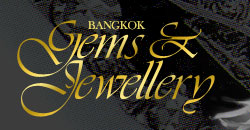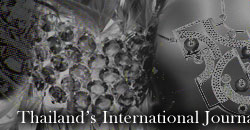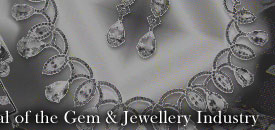|
|
|
| |
|
 |
| |
|
| |
|
|
|
| |
The Antwerp Diamond Museum inaugurated an exhibition about Art
Deco on September 26. This is the first time that diamond jewellery
from the art deco period (1920-1939), deriving from Belgain private
collections has gone on show alongside top quality pieces by Belgain
and French jewellery houses. Among the Belgain jewellers were
Wolfers and Massaux and the French jewellery houses of Cartier,
Boucheron, Fouquet and Laloche Frres were the ones who flourished
during this fascinating time.
The 1920 's were an exciting time to live in. Fortunes were being
made and spent with ease thanks to the prodigious industrial growth
of the era. Money began to be concentrated in new hands, especially
bankers and industrialists and society started to take on a whole
new look. Also after World War I, which was a time of hardship,
people wanted luxury and beauty, comfort and freedom.
Women were gaining emancipation. Short dresses (not minis), skirts
and trousers were now being worn and they were now following new
role models, the first real Hollywood stars like Mary Pickford,
Greta Garbo and Marlene Dietrich among others. Glamourous frocks
and costly jewels were the order of the day.
Diamonds were also in plentiful supply due to the discovery of
the South African mines at the end of the nineteenth century.
It was acceptable to flaunt one ’s wealth and the noveaux riche
ruled the roost. It was a new and exciting era and design reflected
it too. The flowing natural lines of Art Nouveaux were relegated
to the past and instead clean lines, linear and geometric forms
and contrasting colours helds sway.
|
|
|
| |
Pair of
Earrings, Fouquet -,Paris
Circa 1920-1925 |
|
| |
|
|
| |
Brooch,
Belgain, Circa 1935 |
|
|
| |
|
| |
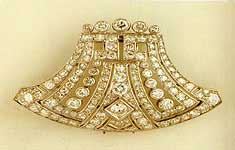
Clip, Massaux- Antwerp, circa 1935
|
These new stylistic elements were very much in evidence at the
Exposition Internationale des Arts Décoratifs et Industriels Modernes
which took place in Paris in 1925. It was this exhibition that
lent its name to the new style : Art Deco.
The most popular items of art deco Jewellery for the daytime
were the brooch and the (double) clip. Belgain firms are represented
in the exhibition mainly by monochrome examples from the later
art deco period (1930 - 1939), the so called " white period
". There are also many jewels in vivid constrasting colours
from the early art deco period as well, which were inspired by
Egyptian, Chinese and Japanese influences.
The Jewellery collection is supplemented by visual material and
accessories such as an evening bag by Janesich, a powder compact
and lipstick holder, a cigarette case by Cartier, etc. One of
the highlights of the exhibitionis an original photo book of art
deco designs from which customers made their choices. It derives
from the House Massaux , which later merged with Emile Anthony
and Wolfers Frères to become ANTHONY (Antwerp). All the photographs
are arranged according to category and all the designs are numbered.
Accompanying it is the Massaux Design Book, which is a collage
of design and sketches. Some of the sketches correspond exactly
to the items that appear in the photo book. Both books are on
display together with design sketches from the Wolfers Frères
archives in Brussels.
|
|
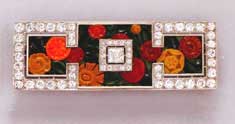
Brooch, Boucheron - Paris, circa 1925
|
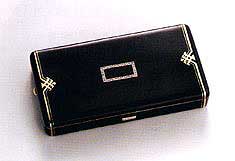
Cigarette
holder, Cartier - Paris, circa 1920-1925 |
| |
The Jewellery exhibition is accompanied by an exhibition
that encompasses the entire era between the two World Wars and
presents a picture of what life was like in Belgium at the time.
The exhibit covers such diverse area like the Red Star Cruise
Line, the 1930 World exhibition that was held at Kiel in Antwerp,
the Imalso tunnels, which were the first to connect the right
and left banks of the River Schelde as well as the graphic art
of the period. It was a time for experimentation, a time for the
celebration of modernism and all its symbols like trains, ships,
aerodynamic aircraft and of course, the skyscraper.
|
|
|
|
|
| |
|
|
(1) Brooch-pendant with hidden watch,
Lang - Paris (2) Pendant with hidden
watch, Thibauli - Paris
(3) Jabot - Brooch - inspired by the Orient,
France (4) Pearl
necklace with pendant shaped like a tassel
|
|
| |
|
| |
|
|
|
|
The American Gem Traders Association (AGTA)
has just released an update regarding blue sapphires that are apparently
from Sri Lanka and which appear to be treated by a new high-temperature
heating technique. The report on the website says that the exact mechanism
of this treatment remains uncertain, but a number of stones in sizes
ranging from 2 to 17 cts. have been seen over the past several months.
The major identifying feature of these stones is a blue core surrounded
by a diffuse colorless or near colorless skin. This is best observed
by immersion in methylene iodide (di-iodomethane) with a diffuse white
plastic filter between the immersion cell and light source in the
microscope.
|
|
|
| The website however makes it a point to
note that all stones placed table down in an immersion cell will show
some lightening of colour at the girdle, since the stone is thinner
at the girdle but the report goes on to say that the stones treated
by this new process show a distinctive colourless rim that penetrates
well into the gem, unlike the normal gradual lightening of colour
towards the girdle in untreated stones. AGTA also says that tests
do not reveal the presence of beryllium and that it is working with
members of the Sri Lankan industry. |
| |
|
|
| |
|
|
| |
|
|
